Posted by Ian Young on 12-09-2002 01:37 PM:
Turkomen Bags
I would appreciate any comments on origin, age and original use of the
following small Turkomen bags.

Number one is 670mm long by 240mm wide excluding the handles
and tassels the back is plain weave in typical red dye.
The weft is a dark
brown wool and can just be seen through a tear in this detail.
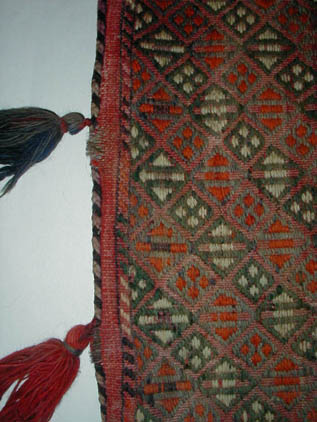
Number two is 320mm by 170 mm and it has a plain weave undyed
back.

Number three is 400mm by 180mm and the only colour
is in the decoration which is applied to an undyed plain weave ground.
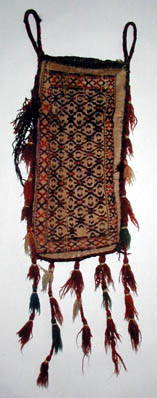
I also have another bag of similar dimensions although very
different in every other way and I have a suspicion that it could be
Uzbek.
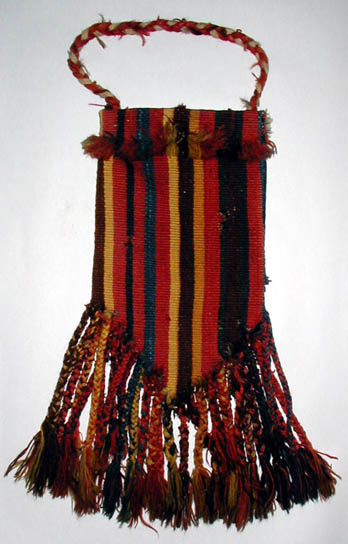
It is 580mm by 250mm including the tassels. The top is just
finished by a simple turn over.
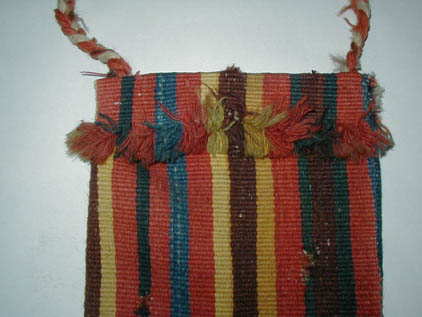
The bottom is closed by the plaiting of the tassels.
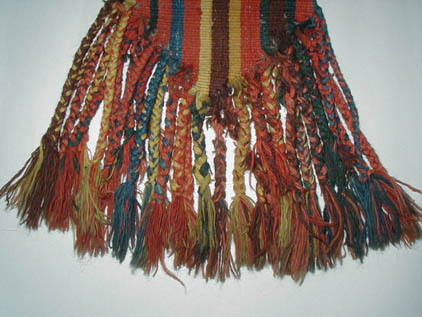
I know none of these bags have any great age but I think that
they display some good tribal character I will be pleased to receive any
comments.
Posted by Steve Price on 12-09-2002 02:47 PM:
Hi Ian,
The four Turkmen pieces are examples of what is usually
thought to be spindle bag (igsalyk) or spoon bag (chemche torba),
although there are published references that include horse feed bag (at
torba), tent strut cover (ok bash) and mirror bag (aina
khalta). All the Turkmen names are transliterations that appear with many
spelling variations.
In an article in HALI (No. 69, p. 77, 1993) I
observed that there were probably as many different names (counting spelling
variants) as published examples, and suggested that we just call them portrait
format small bags. It never caught on.
I wish somebody would do a Salon
on Turkmen flatweaves - there's too little written about
them.
Regards,
Steve Price
Posted by R. John Howe on
12-10-2002 06:17 PM:
Steve -
We might do a salon inviting folks to put up Turkmen
flatweaves they own or have images of, but I think the conversation will be
more shallow than usual, since it is my impression that not much is known about
them.
In the Weidersperg collection catalog by Pinner and Eiland they
had to speak to a couple of Turkmen "palas" (flatwoven rugs) but were very
cautious. They are not able even to offer firm tribal attributions of the two
pieces in that collection (Plates79 and 80).
They indicate that there
"has been no attempt to study (ed. Turkmen palas)".
There is a Paul
Ramsey article on Turkmen flatweaves in ICOC I but I have not read it. Pinner
and Eiland, though, would have, so it's not likely full of things useful for
making the distinctions to which we are attracted.
Marla Mallett may
know quite a bit now about the structures of Turkmen tent bands of mixed
technique and some of that may bear on other Turkmen flatweave usages but she
hasn't published anything, excepting what she has put up on her
site.
Regards,
R. John Howe
Posted by Ian Young on
12-13-2002 01:43 PM:
Thank you Steve and John for your replies, it would seem from what you
are both saying that I am not alone in not knowing much about Torkoman flat
weaves.
I think it would be great to use this forum to try and extend our
knowledge of these fascinating weavings.
We have several other bags mostly
soumac torbas all are very finely woven and some even have silk highlights.
They date back as far as the third or fourth quarter of the 19 century and we
like them very much.
I would be happy to post pictures if you decide to go
down that route.
Regards
Ian
Posted by Steve Price on
12-13-2002 03:43 PM:
Hi Ian,
If you'd like to start a thread on the more general topic
of Turkmen flatweaves (I think it would be better to do that than to divert
this one; we can merge the two later if that seems worthwhile), I invite you to
do so. I think it would make interesting reading, and if the discussion
develops enough substance we can archive it along with the Salons (we now have
four or five non-Salon discussions archived).
Regards,
Steve
Price
Editor's note: Ian did open a new thread on the general topic
of Turkmen flatweaves, and it has been merged into this one.
Posted by Ian Young on 12-14-2002 02:56 PM:
Turkomen Flatweaves
Turkmen torba
I am seeking further knowledge and information on
these Turkmen flat woven torba. The only information that I have is what I have
gleaned from the sale room catalogues which states 'Bags of this type are rare
all known examples seem to have been made at the same time by the same weaving
group.
Torba 1
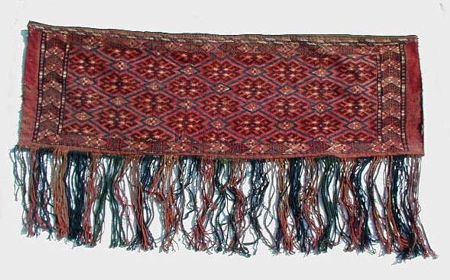
Teke(?) soumac torba, field with all over diamond
lattice outlined in blue grey with small diamonds at interstices and each pink
ground compartment with an elaborate hooked diamond. (Note use of pink and
other coloured silks and cotten highlights.)
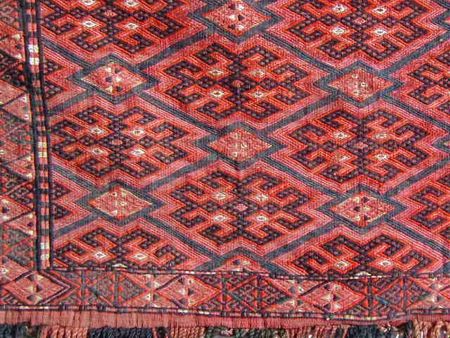
The main border is a naldag variant,two narrow guardstop side
with diagonal lattice, side and base guards with repeated blocks. Added
original plaited fringe and undyed plainweave back. 1.2m x 0.35m
Torba 2
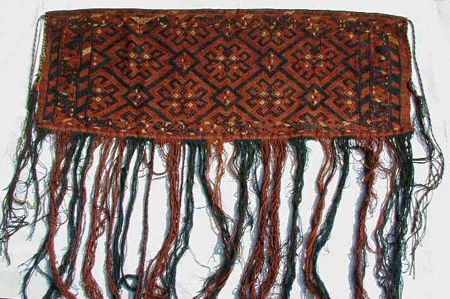
Teke(?) soumac torba central Aisa end 19th century. 1.17m x
0.43m. The wooll of the decoration on this one is not so finely spun so it has
a chunky look to it, it could be by a different group or it could be from a
later date.
Torba 3
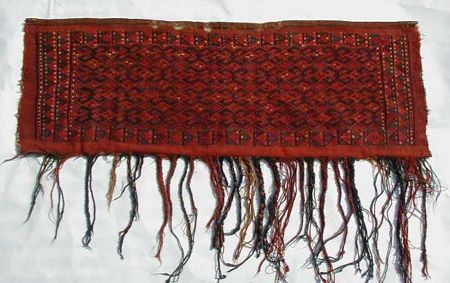
Teke(?) soumac torba with silk
highlights central Aisa end 19th century. 1.27m x 0.43m
Torba 4
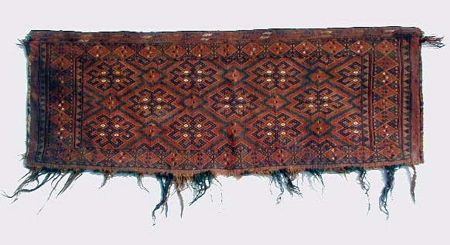
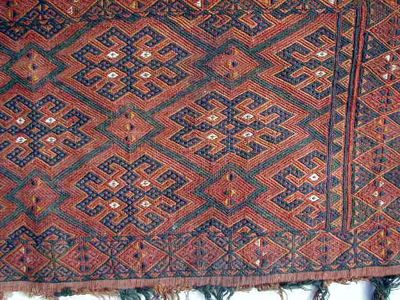
Teke(?) soumac torba central Aisa end
19th century. 1.0m x 0.4m
Torba 5
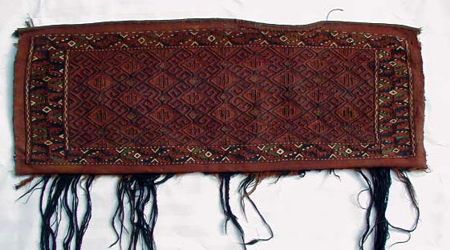
This
one is quite different in style and came as Teke or Ersari soumac torba from
central Aisa, end 19th century.
It has some different colours including
green and is complete with a plain weave back which shows an interesting border
end 19th century.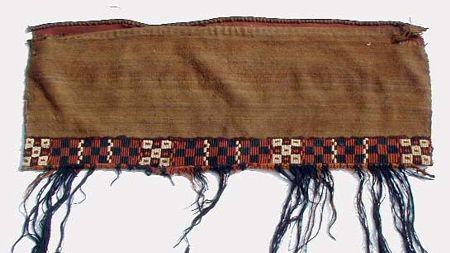
Torba 6
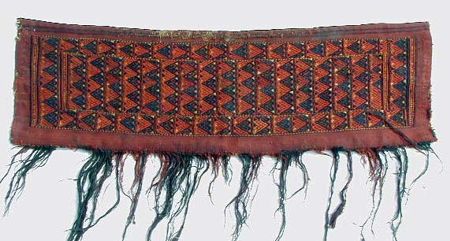
Turkomen soumakh-embroidered torba 1.09m x 0.31m.
Probably
Tekke but with a completely different pattern.
I bought all the above
from two auction sales they were not expensive so I could afford to buy them
all. This made me think they were common but I have not seen another at the
sale rooms for about two years now, they seemed to come in a rush and then
disappear.
The quality of the work is superb and I wish I could find out
more about them.
Posted by Steve Price on 12-15-2002 06:33 AM:
Tribal Attribution
Hi Ian,
Tribal attribution of flatwoven Turkmen bags appears to
be uncharted territory. At least, I haven't run into any written or online
sources of persuasive criteria.
How might we do it? Obviously, we can't
invoke knot type for these, usually the first line of inquiry for Turkmen pile
work. Palette is helpful, but I have seen few Turkmen flatweaves in which the
palette seems unambiguously like those of some tribal group's pile work.
What's left? Design is one. Except for Number 6 in your post, all use
designs that I've seen in Ersari pile torbas, and not in those of any other
group. This suggests Ersari, rather than Tekke, to me.
The only other
criterion I can think of applying is to ask the question, if someone has a
Turkmen piece and we haven't seen it at all, what is most likely to be its
tribal origin? Since the majority of Turkmen stuff in the west is Ersari and
Yomud, we'd maximize the probability of being correct by guessing that it's
Ersari or Yomud. Since Salor and Saryk are the most rare, we'd be pretty safe
in guessing that the piece is not either of those.
Anyone have any more
detailled, evidence-based criteria for making tribal attributions of
these?
Regards,
Steve Price
Posted by
Lavergne_Philippe on 12-15-2002 10:29 AM:
Do you remember we had a nearly similar discussion, with a few
pictures,during january and february 2002. ( 2 pages )
It was about "
Brocaded Okbash "
I kept it, and I can send it back, if you
wish.
Regards
phil
Posted by Steve Price on 12-15-2002 11:04
AM:
Hi Phil,
I do remember, but not the details. If you'll send it to
me, I'll turn it if you'll send it to me I will turn it into an HTML document,
put it into our server, and post a link to it within this
thread.
Thanks, and best regards,
Steve Price
Posted
by R. John Howe on 12-15-2002 02:03 PM:
Dear folks -
Steve and I have reiterated that there is not much
known about Turkmen flatweaves and Philippe has reminded us that we may be
"cycling" a bit in our conversations.
One of the pieces in the last
conversation may have been this one.
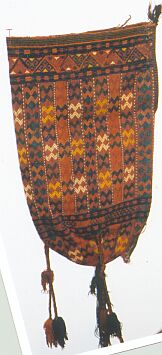
As Steve mentions, Saryk weavings of all kinds are fairly
rare and this group is perhaps not the best candidate for guessing which tribe
might have woven a given flatweave.
Nevertheless, this is one of the few
Central Asian flatweaves I own and Anne Halley, whom I bought it from,
conjectured afterwards that it might be Saryk on the basis of the color palette
and the treatment of the tassels.
There are other Central Asian
flatweaves about that seem well distinguished from those of the western Turkmen
tribes. Here is one quarter of the surface of one large-ish one I own.
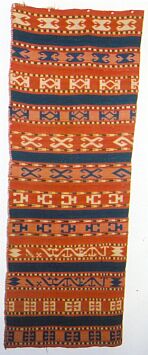
Folks say confidently "Uzbek" about such pieces. They do
seem to have similar designs and a similar structure. They are most usually a
weft-faced plain weave with lots of (extra weft?) "floats" on the back in
design areas.
I don't think these have been studied much either. I just
looked again at O'Bannon's two volumes of translations of Russian scholars who
studied Kyrgyz weavings and they feature mostly pile. The few non-pile pieces
are felts or even embroidered leather. I didn't see any
flatweaves.
Regards,
R. John Howe
Posted by Filiberto
Boncompagni on 12-17-2002 09:02 AM:
Dear all,
Here is the link to the discussion "Brocaded okbas"
mentioned by Philippe:
http://www.turkotek.com/misc_00007/brocaded/Brocadedokbash.html
Regards,
Filiberto
Posted by Ian Young on 12-17-2002 01:42 PM:
Hi All
I missed the discussion the last time round so thank you for
providing this link.
The weavings shown by Phillippe Lavergne and Kelvin
Webb are very close to some of the ones I illustrate above.
Torba #1,#3
& #4 all have various amounts of silk and cotton used as highlights which
is mentioned in your earlier discussions.
The colour of #1 is a pink-red,
just like Kelvins one appears on my monitor, although it has faded form a red
which is in evidence at the upper edge where some canvas had been stiched on to
hold some form of attachment. The others vary from red to brown and at least
one has smoke discolouration. They all have undyed backs which except for #5
are undecorated.
I can see that I will have to try and look at the structure
for some more information.
Has any one seen a Turkoman salt bag ? I have
never even seen a picture or heard any mention of such a thing. Do they exsist
and if not why not?
Regards
Ian
Posted by Steve Price on
12-17-2002 01:56 PM:
Turkmen salt bags
Hi Ian,
I've seen one Turkmen salt bag. It was done in pile, had
an inscription that included a date - 1933, if my memory is correct (which it
hardly ever is).
I don't know why there aren't Turkmen salt bags
around, but I guess they didn't make any in the format that we are accustomed
to calling salt bags. My unreliable memory includes a trace recollection of
someone suggesting that Turkmen territory was such that supplemental salt for
the sheep wasn't needed. I no longer recall who said it, or, of course, whether
the statement is accurate. It seems plausible to me that Turkmen might have
carried salt in a bag with a more conventional shape (rectangular) than the
saltbag form.
Regards,
Steve Price

















